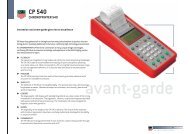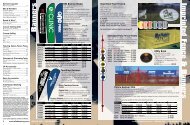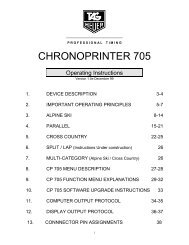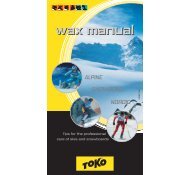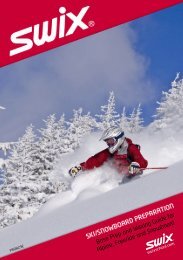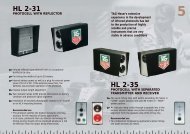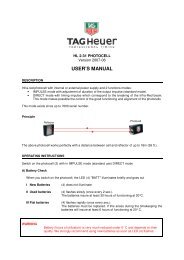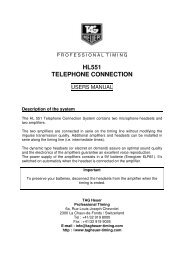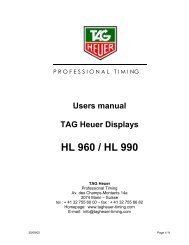Create successful ePaper yourself
Turn your PDF publications into a flip-book with our unique Google optimized e-Paper software.
16 SWIX SPORT TECH MANUAL<br />
Factors Influencing Waxing<br />
Factors Influencing Waxing<br />
Temperature<br />
The temperatures shown on the Swix <strong>wax</strong> products<br />
are normally both snow and air temperatures.<br />
If nothing is specified, the temperatures<br />
are air temperatures. Taking a reading of the air<br />
temperature in the shade is the first basic starting<br />
point for <strong>wax</strong> selection. This should be done at<br />
several points along the course especially keeping<br />
in mind where the most critical point is,<br />
such as a flat section. Snow temperature at<br />
the surface can also be helpful. But remember<br />
that once the temperature reaches the freezing<br />
point (0°C or 32°F), snow will remain at that temperature<br />
regardless of rising air temperature.<br />
At this point it is best to use air temperatures<br />
and focus on the proper steps for dealing with<br />
the increased water content of the snow.<br />
Humidity<br />
Humidity is important, but more as a local climate<br />
trend rather than a need to measure every<br />
percentile. It is important to know if the competition<br />
is taking place in a dry climate, meaning<br />
average humidity below 50%; a normal climate<br />
of 50% to 80%, or a high humidity climate 80%<br />
to 100%. Beyond this, of course, is adjusting to<br />
the situation of falling precipitation.<br />
Snow Granulation<br />
The appearance of the snow crystal and consequent<br />
snow surface is important for <strong>wax</strong> selection.<br />
Falling, or very fresh new fallen snow is the<br />
most critical situation for <strong>wax</strong>ing. The sharp crystals<br />
require a <strong>wax</strong> that will resist snow crystal<br />
penetration, but at warmer temperatures must<br />
also have the ability to repel water. It is in this<br />
special, critical <strong>wax</strong>ing situation that Cera F<br />
excels.<br />
www.swixschool.com<br />
Man-made snow is today the most common<br />
snow in racing situations. Freshly made snow at<br />
cold temperature definitely require the addition<br />
of synthetic paraffin such as with CH4, LF4, HF4<br />
and CH6, LF6, and HF6. After man-made snow<br />
has “settled” for some days and the surrounding<br />
atmosphere has affected the snow surface, the<br />
gliding characteristics of the snow improve and<br />
normal <strong>wax</strong>ing considerations return.<br />
At rising air temperatures above 0°C (32°F)<br />
the snow temperature still remains at 0°C (32°F).<br />
The water surrounding the snow crystals increases<br />
until the snow pack becomes saturated with<br />
water. Waxes that are highly water repellent and<br />
coarse base structures are needed.<br />
Snow Friction<br />
The friction on ice and snow is a mixed friction.<br />
It means that it is neither a true dry friction nor<br />
a true fluid friction. The contact is partly dry,<br />
partly wet. At very low temperatures the frictional<br />
mechanisms gradually might be described by<br />
laws governing dry friction.<br />
At intermediate freezing temperatures,<br />
around -4°C to -10°C (25°F to 14°F), the water<br />
film between the frictional partners has the optimal<br />
thickness to create low kinetic friction.<br />
Approaching the freezing point, the water film<br />
increases in thickness, and when conditions for<br />
melting is present, free water enters the system.<br />
The contact area between ski and snow<br />
increases and the friction will increase.<br />
Suction gradually builds up as the amount<br />
of water increases.



